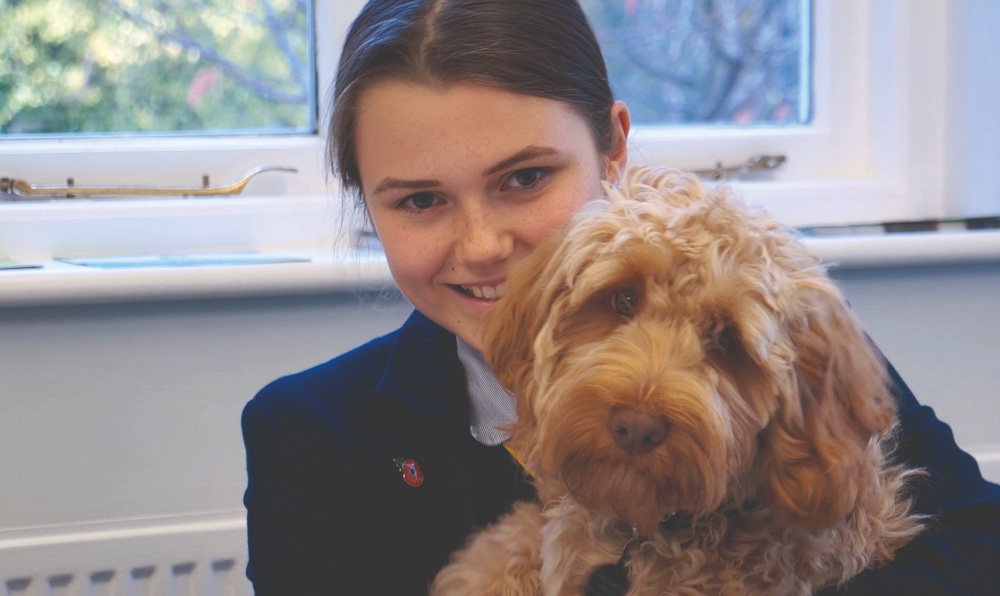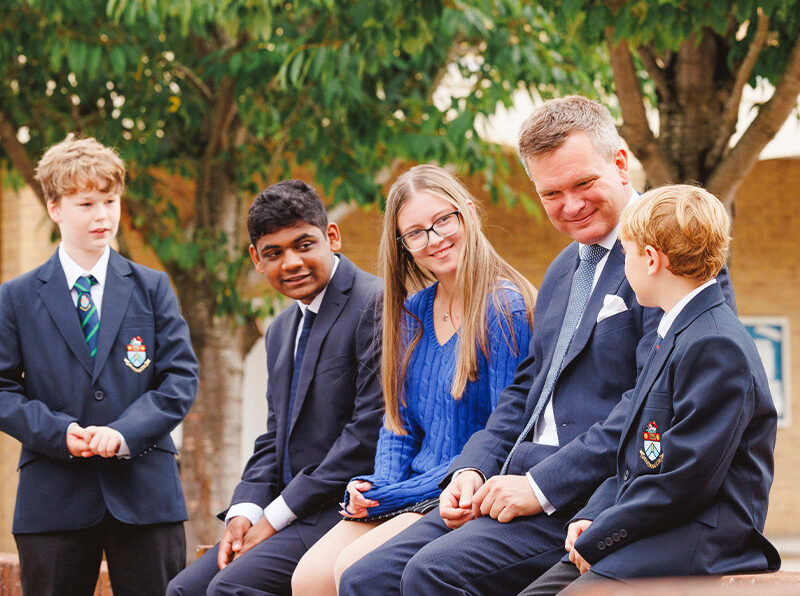
Supporting Children’s Mental Health
Jenny Booth looks at what schools are doing to look after their pupils’ wellbeing
From an emotional support puppy in the school corridor, and environmental projects in the community, to meditation and Tibetan singing bowl workshops for stressed out exam students – in many different and imaginative ways, schools are embracing the challenge of looking after the mental health and wellbeing of their students.
And a good thing, too. The latest research from NHS England, published in November 2018, reports that one in eight school age children is suffering from a diagnosable mental health condition. That statistic has been creeping steadily upwards: 12 years ago it was one in 10. Anxiety and depression are the most common disorders, and girls aged 16-19 have shown the biggest decline in wellbeing.
Chasing perfection can be toxic, with young people reporting pressure to excel at school and to look good as their biggest issues. Conflict at home and with friends are also important stressors, according to the charity Young Minds.
In response, many schools are expanding their remit to include teaching young people about mental health, and what they as individuals need to do to stay well. The new buzz word is resilience, which means the capacity for a child not to be demolished when things go wrong, but to find a way through.
So how do you encourage resilience? Putney High School has been shortlisted for a national award for its pioneering Breathe programme, which comprises an evergrowing number of wellbeing initiatives, starting with the healthy self, and widening out to include relationships, being involved in the wider community and protecting the environment.
From Year 7, pupils talk about mental health in PHSE lessons and are taught to use the Positive app, a digital wellbeing toolkit which encourages them to check in with their emotions every day. The app’s “Emotional Barometer” helps them become more aware of their emotional ups and downs, and what triggers them, while the “Inner Coach” helps them learn how to dispel the negative selftalk of their “inner critic”.
“Physical and mental wellbeing have to be at the top of our agenda at all times,” says Heidi Armstrong, Deputy Head Pastoral at Putney High.
Some schools have introduced mindfulness meditation, teaching a focus on the breath and the body to help pupils to develop better mental balance. Pupils at Claremont Fan Court School receive training from the school’s Mindfulness Coordinator, and a Peace Garden has been set aside in a quiet part of the grounds for pupils and staff to practise mindfulness.
Clare Morgan, a trained Mindfulness in Schools Project teacher at Mindfulness Wimbledon, says, “I think it’s the present moment awareness at the heart of mindfulness that helps young people and their teachers and parents to develop greater emotional resilience and learn to be kinder both to themselves and to others.”
At Parkside School in Cobham, teachers run chill and chat sessions, and break time activities like fruit kebab-making, mindfulness colouring and origami. Senior boys have designed a wellbeing walk around the school, with inspirational quotes. “Resilience, self-esteem, independence, cooperation and collaboration are covered in school assemblies,” says Nick Procter, Head of Pastoral Care.
Many schools put in extra support for children at the most stressful times, particularly around GCSEs and A Level. Yoga is a popular choice, though it is important to adapt the practice for young people and make it fun, says yoga guru and wellbeing practitioner Doretta Natalucci, who works in three south London schools.
“The first 20 minutes might be just giggling and laughing and getting it out, doing funny poses. You have to engage them and excite them and then get them thinking,” says Natalucci, who includes Tibetan singing bowls in her sessions.
The catalyst for this sea change in schools has not been simply the statistics but the tragic case of North London schoolgirl Molly Russell. Molly was 14 when she ended her own life, in 2017, after viewing graphic content about suicide and self-harm on social media. “I think Molly probably found herself becoming depressed,” Molly’s father told BBC News. “She was always very selfsufficient and liked to find her own answers. I think she looked towards the Internet to give her support and help.”
Molly’s death has led to an upsurge in interest in diverting young people away from their devices and giving them safe ways to express their feelings. Opening up can be hard for youngsters, who often assume that painful feelings are their own fault. To take the first step, they need to find someone they trust. Research shows that the people that youngsters turn to most are their friends (71%) and parents (66%), but the next most likely port of call is a trusted adult at school (56%).
This makes school relationships vitally important. Many schools have put in place befriending and peer-mentoring programmes, and made a professional counsellor available. At Burgess Hill Girls, a 4-18 school in Sussex, every girl chooses an adult to be their mentor.
“Every child has one adult who knows them really, really well, someone who’s interested in them,” says head teacher Liz Laybourn. “If we nurture children and they know that we know them quite well, they are more likely to share when things aren’t going well.”
At the Mall School, a boys’ prep in Twickenham, pupils from Years 4 – 8 were given a survey asking them to respond to 20 statements on the themes of confidence and resilience, independence and friendship. As a result, the school has made changes to PHSE lessons, and put mentoring and social skills sessions in place for boys who needed support.
Teachers are not trained in how to support children’s mental health, but the government has just started to roll out initiatives to every state school under the Link programme, led by the Anna Freud Centre. Professor Jessica Deighton, Director of Innovation, Evaluation and Dissemination at the Anna Freud Centre, stresses that it is important not to define resilience too narrowly, putting the onus on the child to be braver. All the important parts of a child’s world – school, parents, friends – need to work together to be supportive, to create a resilient network.
It isn’t always easy for parents to know how to support their children. They may be struggling themselves, not realising that in unspoken ways they are passing their stress on. Some wellbeing practitioners now work privately with families as well as in schools. “I have observed how when a parent is able to work at their own stress reactivity and general anxiety, the children too are able to regulate their emotions better and the family can learn to flourish,” says Benedicte Long, a clinical hypnotherapist and mindfulness teacher at Mindfulness Wimbledon.
Burgess Hill Girls runs seminars for parents, helping them to understand what it is like growing up in today’s world, and how to intervene to support their child’s mental health.
“The schools that impress me most are the ones with strategic leadership thinking about mental health and multiple ways of supporting students embedded in the school, rather than just having one intervention like a sticking plaster,” says Prof Deighton. Key is simply to normalise talking about mental health, she adds. “Everyone has mental health.”
Because it is a new area for schools, Prof Deighton recommends that they monitor their support programmes to make sure they are working, at least until a major government-funded evaluation project reports back in 2021. Getting it right is important, as unresolved mental health problems in childhood lead to continuing struggles in adult life. Half of all adults with mental health issues started to experience problems before the age of 14.
Sometimes the simplest approaches are the most effective. The arrival of Jasper the puppy has transformed the atmosphere at Burgess Hill Girls. Head teacher Mrs Laybourn says: “I can honestly say that the difference in school is incredible.”
Factors Affecting Mental Health
• Pressure to do well at school or college 77%
• Worrying about how you look 69% • Problems with family 62%
• Problems with friends 52%
• Traumatic experiences 46%
• Bullying 41%
• Not having enough money 32%
• Worrying about getting a job 29%
• Problems with physical health 27% • Spending too much time on social media 27%
Source: Young Minds, survey of 7,083 young people experiencing mental health difficulties, August 2019 (respondents ticked all which applied)
Is Your Child’s School Promoting Wellbeing? What to Ask:
• Does the school have a mental health policy?
• Is there a senior member of staff who leads on mental health?
• Is mental health covered in the curriculum?
• Is extra support put in place around exams?
• How does the school listen to students’ views?
• What are the procedures if a student is seen to be struggling?
• How does the school involve parents and carers in wellbeing?
• How does the school monitor whether its mental health policy is working?
Source: Professor Jessica Deighton, Anna Freud National Centre for Children and Families.
FOR FURTHER INFORMATION: annafreud.org, dorettayoga.com mindfulnesswimbledon.com, youngminds.org.uk






